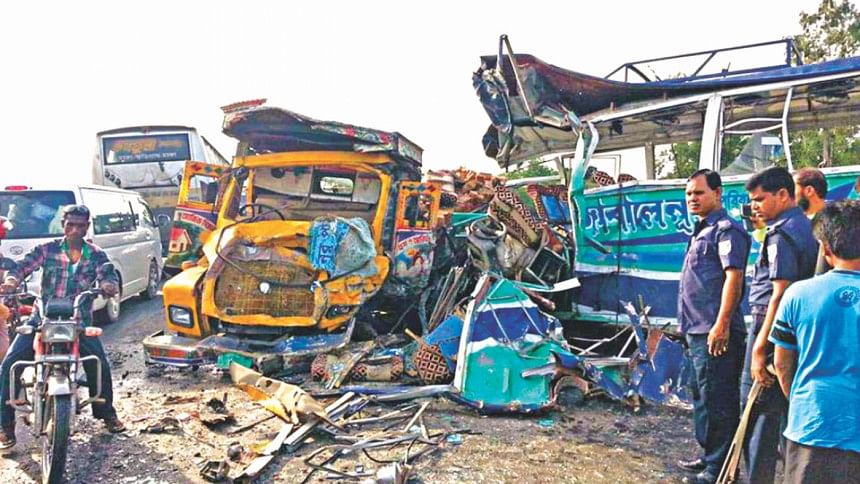Futility of cosmetic road safety measures

Only around a year or so ago, three-wheelers were banned from plying on highways. It was claimed by the authorities that the manually-operated and battery-charged three-wheelers were a serious concern for mainly two reasons, namely: increasing road safety and reducing congestions on highways. In this newspaper, I had argued that while three-wheelers are structurally hazardous types of vehicles, the ban was abrupt and was likely to make little or no contribution to either of the two reasons given by the authorities. The failure of the move yet again shows that a cosmetic approach to road safety, focusing on soft targets, would fail to bring about any overall improvement in road safety. Cynics could argue that had the target group been much more organised like the powerful owners or workers association of buses and trucks, there was little prospect for the authorities to take any such abrupt decision, however beneficial it could potentially have been, either in the short or longer term. On September 17 2016, the Road Transport and Bridges Minister, Mr. Obaidul Kader squarely blamed the reckless drivers and plying of three-wheelers on highways for the occurrence of a very high number of accidents during the recent holiday season. As candid an admission as it may be, it also sounds like a statement of surrender.
According to statistics available in the Bangladesh Road Transport Authority's Website, from 1994 to 2014, there has been no noticeable improvement neither in the reduction of accidents nor in the number of casualties (http://www.brta.gov.bd/road-safety.html). Most private sources and media reports argue that the official statistics mainly relying on police reports significantly underreports the number of road accidents and casualties. The fatalities on roads have been so routine an affair, that had they been not so high in numbers over a relatively short span of time, and had it not been a relatively lull period for headlines in the newspapers, news of many of the accidents would not have even found a place in the front pages of the national newspapers. It is well-known that in the last couple of decades, the length, breadth, and quality of paved roads and associated infrastructure in Bangladesh have improved.
Thus, ceteris paribus, the overall (thus not to imply that all roads fall in this category) improved quality of roads and associated infrastructure should have had a palpable positive impact on road safety in Bangladesh. It is conceded that over the same period of time, the number of vehicles plying on roads too has increased exponentially. Nonetheless, improved road conditions and administrative vigilance should have had some noticeable contribution to road safety which does not seem to be the case. The answer to this paradox may lie in the fact that the quality of roads is only one of the critical factors of road safety or even road congestions. The road-worthiness of vehicles, the capacity of the drivers driving them, and the regulators working on road safety and maintenance are indispensable elements of road safety, etc. When drivers are reckless, vehicles are seriously unworthy of plying on roads, and regulators fail to perform their functions to any satisfactory level, better roads may be speedier but may not be any less lethal. This is evident from the fact that lethal accidents have often taken place at times when there were no real road congestions. In a similar vein, only a handful of vehicles unworthy of plying on roads may not directly cause road accidents.
Various organisations such as the Passenger Welfare Association of Bangladesh (PWAB), Nirapad Sorok Chai Andolon, and Centre for Injury Prevention and Research etc. have conducted research and made suggestions for improving road safety and reflecting on them is not possible within the space of this column. It may suffice to say that their suggestions can be classified into structural and long-term improvement of roads and associated infrastructure which needs technical expertise, time, and substantial investment on the one hand and the scrupulous implementation of existing laws and administrative vigilance, on the other hand, many of which can be implemented without any substantive investment or technical expertise.
Let us look at just one example of a serious problem in the administrative measures. In a roundtable discussion entitled 'How to Make Our Roads Safer' organised by The Daily Star in October 2015, the Chairperson of Bangladesh Bu-truck Owners Association stated that there are many more registered vehicles than the number of registered drivers in Bangladesh which he suggested implies that there is a very high percentage of fake driving licenses. There can be other possible explanations such as some drivers having multiple vehicles, but in a country like ours, individuals owning multiple vehicles may be rare. Thus, the explanation given by him becomes all the more plausible. So, identifying drivers without any licence or driving with a fake licence and making them face the proper course of law can be a very important first step for significantly improving road safety. Road transport authorities have to be given some credit for some sporadic measures against unsafe vehicles but, almost always, they had to cave in because of the very significant pressure exerted on them by the associations of workers and owners of buses and trucks. And if they cannot be emboldened by strong political will and public support, there is no hope that the measures advocated here would be meaningful.
The writer is an Associate Professor, School of Law, BRAC University.

 For all latest news, follow The Daily Star's Google News channel.
For all latest news, follow The Daily Star's Google News channel. 



Comments